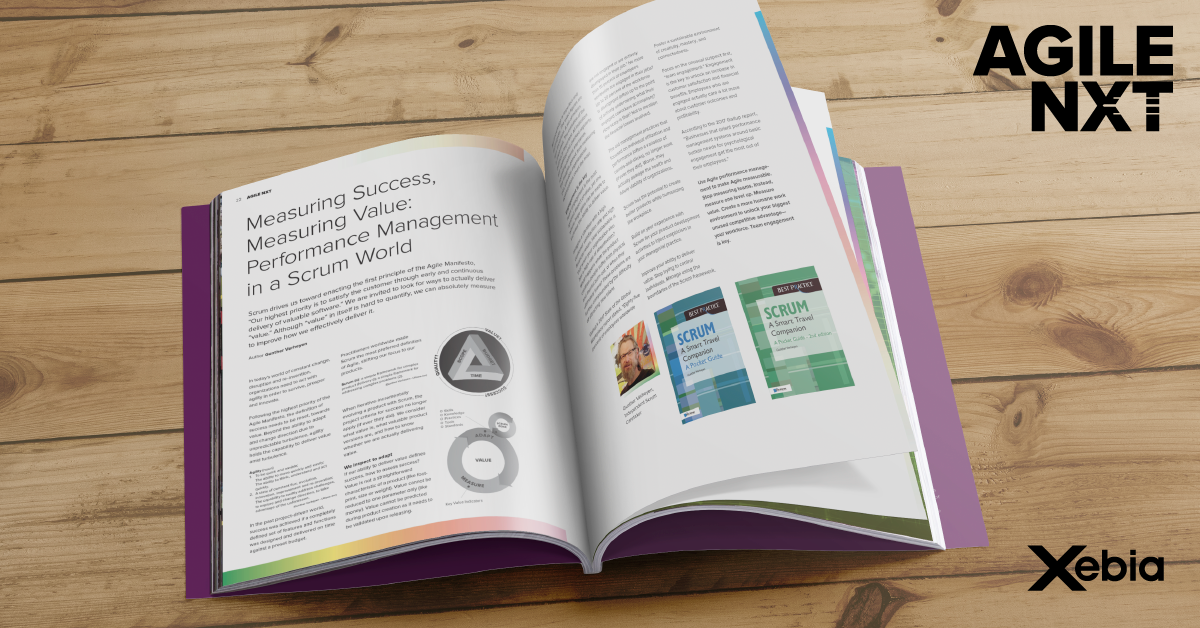Scrum drives us toward enacting the first principle of the Agile Manifesto,“Our highest priority is to satisfy the customer through early and continuous delivery of valuable software.” We are invited to look for ways to actually deliver “value.” Although “value” in itself is hard to quantify, we can absolutely measure to improve how we effectively deliver it.
In today’s world of constant change, disruption and re-invention, organizations need to act with agility in order to survive, prosper and innovate.
This article is published in  AGILE NXT - New Insights for Agile Performance Management. Agile NXT is the magazine full of inspiration for professionals on the emerging Agile journey. Theme of #2: New Insights for Agile Performance Management.
AGILE NXT - New Insights for Agile Performance Management. Agile NXT is the magazine full of inspiration for professionals on the emerging Agile journey. Theme of #2: New Insights for Agile Performance Management.
Following the highest priority of the Agile Manifesto, the definition of success needs to be reset, towards value. Beyond the ability to adapt and change direction due to unpredictable turbulence, agility holds the capability to deliver value amid turbulence.
Agility (noun)
1. To be quick and nimble;
The ability to move quickly and easily;
The ability to think, understand and act quickly.
2. A state of constant flux, evolution, innovation, improvement and re-invention; The capability to swiftly address challenges, to explore and change direction, to take advantage of the unforeseen.
(Gunther Verheyen - Ullizee-Inc)
In the past project-driven world, success was achieved if a completely defined set of features and functions was designed and delivered on time against a preset budget. Practitioners worldwide made Scrum the most preferred definition of Agile, shifting our focus to our products.
Scrum (n): a simple framework for complex product delivery (l); a simple framework for addressing complex problems (2).
(Gunther Verheyen - Ullizee-Inc)
When iterative-incrementally evolving a product with Scrum, the project criteria for success no longer apply (if ever they did). We consider what value is, what valuable product versions are, and how to know whether we are actually delivering value.
We inspect to adapt
If our ability to deliver value defines success, how to assess success? Value is not a straightforward characteristic of a product (like footprint, size or weight). Value cannot be reduced to one parameter only (like money). Value cannot be predicted during product creation as it needs to be validated upon releasing.
Value is reflected in the impact of a product. Value is in the outcome of our work. A team’s productivity is not an indicator of value. The ability to produce large amounts of product is not a guarantee of value. Value is not in volume. We need to measure (at least) one level up. We need “key value indicators” (KVI) to inspect and determine whether we are actually delivering value.
Scrum implements empiricism to increase an organization’s agility. We inspect in order to adapt. An organization’s work outcome is the best place to look to determine whether or not it’s delivering value. These observations should then inform the organization on how to optimize the way the product is created and maintained.
An “empirical management” approach requires inspection and adaptation on value.
The KVIs indicate whether value is delivered, or not. If not, or not as expected, a closer look is needed at how the value is (tentatively) produced; the processes, practices, and tools being applied.
Every Sprint is an investment in an observable outcome, a new product Increment. Every Sprint Review offers an opportunity to assess whether value is being delivered.
Through observation, business hypotheses are validated (or negated), with the option of(potentially radically) changing course or direction in-between Sprints.
Has the Increment been released, or does it have all the qualities to be releasable? How much value has the team (potentially) delivered during the Sprint? We move away from judging individuals for hours spent on tasks and instead, drive the improvement of the working environment forward. Our purpose is to identify and align with the highest value to work towards next.
Yes, we can… measure
The ability to deliver value is typically reflected in a combination of parameters, like:
The capability to regularly satisfy and impress users and consumers, at a reasonable cost and a positive financial return for the organization, in a sustainable and enjoyable way for those creating and sustaining the product.
This converts into KVIs such as: Customer satisfaction (e.g. product NPS),
Revenues or profits, and Team engagement rate.
All knowledge is imperfect and incomplete. The exact figures are less important. A set of metrics is important. The evolution of the metrics is important. All indicators are updated and checked regularly, revealing patterns and trends. The insights gained from measuring into valuable organizational optimizations count the most.
Engagement is the key
Team engagement is the most ignored aspect of value, yet one where huge gains can be made to increase the ability to deliver value.
Imagine a situation with a high customer satisfaction rate and high financial return. How sustainable is that when your organization also has a high rate of absenteeism? What happens when the product creation people suffer from physical and mental burn-out, or when they ultimately leave? These problems are further compounded by the difficulty of attracting new talent.
Gallup’s 2017 State of the Global Workplace report stated, “Eighty-five percent of employees worldwide are not engaged or are actively disengaged in their job.” No more than 15 percent of employees worldwide are engaged in their jobs? Up to 20 percent of the workforce is disengaged (often up to the point of actively undermining what their engaged coworkers accomplish)? How scary is that? Not to mention the financial losses involved.
The old management practices that focused on individual utilization and performance (often a variation of carrots-and-sticks), no longer work(if ever they did). Worse, they actually damage the health and future viability of organizations.
Scrum has the potential to create better products while humanizing the workplace.
Build on your experience with Scrum for your product development activities to inject empiricism in your managerial practice.
Improve your ability to deliver value. Stop trying to control individuals. Manage using the boundaries of the Scrum framework. Foster a sustainable environment of creativity, mastery, and connectedness.
Focus on the unusual suspect first, “team engagement.” Engagement is the key to unlock an increase in customer satisfaction and financial benefits. Employees who are engaged actually care a lot more about customer outcomes and profitability.
According to the 2017 Gallup report, “Businesses that orient performance management systems around basic human needs for psychological engagement get the most out of their employees.”
Use Agile performance management to make Agile measurable. Stop measuring teams. Instead, measure one level up. Measure value. Create a more humane work environment to unlock your biggest unused competitive advantage—your workforce. Team engagement is key.
Want to know more about this topic? Download  AGILE NXT - New Insights for Agile Performance Management and start your personal change tomorrow. And join us for the Future Friday, the 1 day hands-on conference to inspire you to set the next step in agile.
AGILE NXT - New Insights for Agile Performance Management and start your personal change tomorrow. And join us for the Future Friday, the 1 day hands-on conference to inspire you to set the next step in agile.






